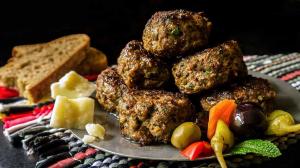You know when you think people 'know stuff' but they actually don’t ? Fool that I am, I often forget this ! Many people’s culinary backgrounds & experiences are most often quite different from your own. It was time for me to explain KEFTEDES more precisely even though I had already posted a recipe using keftedes/greek meatballs in mini pita hamburgers (see recipe here) but I didn’t get into the details because it was a sandwich that had extra toppings and not a stand-alone type of preparation and maybe not requiring precise details on how to make them in order to be ‘truly exceptional’ & ‘particularly herby’ when eaten as is (and not necessarily in or part of something) !
KEFTES (large) or KEFTEDES (medium) or KEFTEDAKIA (when they’re really small & cute) better known as Greek meatballs and quite similar to “KOFTA” from the Balkans to the Middle East to Central Asia and even Southern Asia and are a relatively simple preparation (if you’ve made them before) but perhaps requiring some ‘tips & tricks’ for the uninitiated.
After 1 month of vegetarian recipes, it was time to celebrate my return with some meaty stuff … “sorry”, I am how I am (an omnivore). And yet these meatballs are so “HERBY-FRESH” that it’s kind of a compromise, right ?! Okay maybe, not. But I had friends over from Montreal and I felt like preparing an array of ‘MEZZE’ Greek appetizers, so the occasion was just right.
KEFTEDES are not hamburger patties. They can exist alone as well as be accompanied with little side dishes and other flavors. They can be a full meal, when made larger, or appetizers when made smaller. They can be eaten simply with bread or included in other preparations whether oven-baked or on the stove-top, usually accompanying cooked potatoes, green beans, some tomato sauce, pasta, rice, etc.
Here, they’re stand-alone and this is my version of the recipe. In the end, only you can decide what you prefer. Try them out once and then make your adjustments. Whatever you do and before rolling all of them up in meatballs, do a frying-test with one, taste, then adjust (always adjust to your taste). Do a second frying-test if necessary, then roll them all up and fry them all up and/or freeze some.
*I like to freeze about half or two-thirds of the raw mixture each time (using silicon molds), and once they’re rock-solid, I pop them out of the molds and put them in freezer bags. I try to think ahead and be ready for those days when cooking is not an option nor a desire (12 hours of thawing time in the refrigerator is fine or just take them out the night before).
It’s good to think ahead, you never know.
I have 7 weeks of intense work coming up, so I’m being trying to wiser (and not just older) . . . :)












